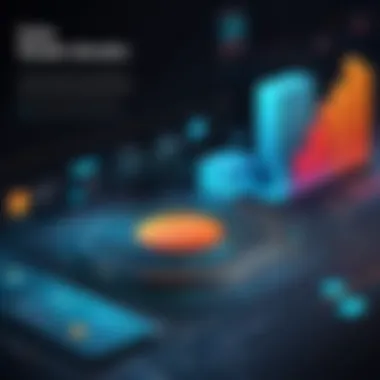Exploring Data Creativity: Merging Insight and Imagination


Intro
In an age where information reigns supreme, the ability to translate data into imaginative solutions has never been more relevant. The fusion of data science and creativity can lead to dynamic narratives and innovative approaches to problem-solving. This article seeks to provide insight into how leveraging both analytical insights and creative thought can enhance decision-making processes and lead to impactful results across various fields.
Technology Insights
Merging Data and Creativity
Technology is evolving rapidly, allowing professionals to harness data in unprecedented ways. Recent advancements in artificial intelligence and machine learning have opened up new avenues for creativity in data analysis. Individuals can now explore significant patterns and trends that were previously hidden within vast datasets.
Among the latest trends, tools like Tableau and Power BI facilitate data visualization, lifting raw information into stunning visuals that tell a deeper story. Such visualizations are not just aesthetically pleasing; they are also instrumental in deriving insights that can shape strategic decisions.
Innovation in Technology
Innovation drives the use of data creatively. Companies continue to invest in technologies that promote data-driven design thinking. Startup organizations are blending their analytics departments with creative teams to reinvent their strategic outlook. This cross-disciplinary approach nurtures a culture where data insights lead to innovative solutions.
"Incorporating creativity into data analysis not only enhances understanding but also fosters a collaborative environment that motivates teams to explore new possibilities."
Moreover, cutting-edge platforms, like Microsoft Azure and Google Cloud, offer robust data management solutions. They help businesses streamline their processes, allowing them to focus on gleaning insights rather than getting bogged down by data handling. Each of these tools plays a critical role in enabling creativity in data analysis, ensuring that creative strategies are grounded in solid insights.
Case Studies of Data Creativity
Examining successful case studies can provide insight into effective strategies. For instance, Netflix employs sophisticated algorithms to analyze viewer data, tailoring content recommendations to individual preferences. This use of data not only enhances user experience but also drives engagement and growth.
Similarly, organizations like Airbnb utilize data creatively to refine their service offerings. By analyzing user reviews and booking patterns, they adapt their strategies to meet evolving customer demands. These examples underscore the importance of a creative approach to data, emphasizing innovative thinking's potential to impact user engagement and business success.
Closure
Prologue to Data Creativity
Data creativity represents an evolving field that juxtaposes deep analytics with imaginative thinking. In our increasingly data-driven world, the necessity for making sense of vast amounts of information is paramount. This section will explore the essence of data creativity, its definition, and its significance in today's digital landscape. Understanding these components creates a framework for recognizing how creativity can be infused into data projects.
Defining Data Creativity
Data creativity is not merely about working with numbers or charts; it involves the art of transforming raw data into compelling narratives. It is where analytical skills merge with creative thinking, allowing for the synthesis of insights that might not be immediately clear from the data alone.
At its core, data creativity entails:
- An analytical mindset that encompasses data gathering and interpretation.
- The use of storytelling techniques to present findings in an engaging manner.
- Innovative approaches to visualize and communicate insights, making data accessible to wider audiences.
By effectively leveraging creativity within data contexts, professionals can uncover deeper meanings in their analysis. This approach is not limited to any specific domain. Whether in business, education, or healthcare, the ability to narrate a compelling data story is invaluable.
Importance in Today’s Digital Landscape
The digital marketplace thrives on data. Companies are collecting immense quantities of information daily. However, merely collecting data does not yield value. Herein lies the importance of data creativity. It serves as the vital bridge that transforms statistical figures into actionable strategies.
Some critical aspects of its importance include:
- Enhanced Decision-Making: Organizations using creative thinking in data analysis often find themselves making informed decisions faster and with more confidence.
- Improved Communication: Clear and creative presentations of data foster better understanding among stakeholders and can drive collaborative efforts.
- Innovation: Companies that integrate data creativity into their processes tend to develop innovative products and services that stand out in competitive environments.
"Data creativity empowers decision-makers to look beyond the obvious and inspires innovative solutions based on informed insights."
In summary, data creativity is central to optimizing the use of information in professional settings. It is a vital skill that enables tech-savvy individuals to communicate effectively and lead with data-driven insights.
The Relationship Between Data and Creativity
Data and creativity might seem like opposing forces at first glance. However, when examined closely, it becomes clear that they can complement each other significantly. Understanding this relationship is crucial, especially in the context of today's information-driven environment. Data creativity enables the transformation of raw data into insights that drive innovation. This transformation is not merely about analyzing numbers but about deriving meaning from them.


One of the core elements of this relationship is data structuring. Well-organized data paves the way for creative exploration. When data is structured effectively, it enhances the ability to identify patterns and anomalies. By doing this, it empowers individuals and organizations to make informed decisions. Structured data enables users to visualize and contextualize information better, making creative interpretations easier. Thus, the better the structure, the more room there is for inventive thinking.
Understanding Data Structures
Data structures serve as the backbone of data analysis. They determine how data can be accessed and utilized. Common structures include arrays, tables, lists, and graphs. Each structure possesses inherent characteristics that influence how information can be interpreted and visualized. For example:
- Arrays allow for straightforward access, making them ideal for simple calculations.
- Tables provide a comprehensive overview, which is beneficial for comparing multiple datasets.
- Graphs facilitate visual storytelling, revealing trends and relationships that numbers alone cannot.
By selecting the appropriate data structure, analysts can optimize both the process of analysis and the resultant creativity. Furthermore, good structuring limits the chances of encountering data overload, which can hinder effective creative thinking.
Creative Thinking in Data Analysis
The process of creative thinking in data analysis goes beyond mere crunching of numbers. It requires an open mind and the ability to question assumptions. Analysts must pose hypothesis-driven questions, thereby exploring various dimensions of the data without allowing preconceived notions to limit their findings.
Key considerations while engaging in creative data analysis include:
- Divergent Thinking: This promotes generating multiple solutions for a given problem, which is essential for finding innovative insights.
- Collaborative Approaches: Engaging with others can spark ideas that wouldn’t surface in isolation. Team sessions can amplify creativity by combining diverse perspectives.
- Iteration: Allowing for repeated cycles of analysis enables the refinement of ideas. Each iteration brings new discoveries that can shape creative outputs.
In summary, the relationship between data and creativity is intricate and essential. A profound understanding of data structures and a commitment to creative thinking are paramount for harnessing data’s potential. Engaging with both can lead to more impactful storytelling and solutions across various domains.
"Data without creativity is simply noise. To make sense of it, we must imbue it with imagination."
Thus, as we delve deeper into fostering data creativity, it is essential to keep the balance between structured data and innovative thinking.
Methods to Foster Data Creativity
Developing data creativity is crucial in today’s data-driven world. It enables individuals and organizations to extract valuable insights from complex datasets. By fostering this creativity, one can translate raw data into compelling narratives and innovative solutions. Future success in various fields often hinges on the ability to creatively engage with data. This section outlines the methods that can most effectively nurture this skill, providing tools to enhance analytical thinking.
Analytical Frameworks
Analytical frameworks serve as structured approaches to understanding data. These frameworks are essential in ensuring systematic analysis and interpretation. With a clear framework, it becomes easier to manage vast datasets. It can facilitate identifying trends and patterns that may not be immediately evident. Establishing a solid analytical framework also promotes critical thinking.
One effective framework is the Data-Information-Knowledge-Wisdom model, which outlines the stages of data processing. By applying this model, professionals can refine their analyses at each step:
- Data: Raw facts that need organization.
- Information: Organized data, providing context.
- Knowledge: Insight derived from analyzing information.
- Wisdom: Application of knowledge in decision-making.
Another example is the Design Thinking method, which promotes empathy and understanding users' needs. It encourages iterative prototyping and testing, helping to cultivate creativity in data-driven projects.
Mind Mapping Techniques
Mind mapping is a visual tool that enhances the concept of data creativity. It allows individuals to brainstorm ideas organically and see connections clearly. By mapping out thoughts, professionals can engage with data more meaningfully. This technique helps structure information logically, which can spark innovative ideas.
Creating a mind map involves curating central themes and branching out relevant concepts. This visual representation aids memory retention and allows teams to explore options freely. Mind mapping can be effectively blended with data analysis. For instance, when analyzing customer feedback data, stakeholders can visually pinpoint pain points, leading to creative solutions.
Benefits of mind mapping include:
- Enhanced Memory: Visual representations improve recall.
- Boosted Creativity: Non-linear exploration of thoughts encourages innovation.
- Clearer Communication: Visual aids facilitate discussions and understanding among team members.
Collaborative Brainstorming Sessions
Collaborative brainstorming is an essential part of fostering data creativity. Bringing together diverse minds can significantly enhance the outcome of data-driven projects. Different perspectives lead to richer discussions and often unveil new insights that an individual may overlook.
Effective brainstorming sessions should include:
- A Safe Environment: Encouraging openness and free-thinking is key.
- Clear Objectives: Define what the session aims to achieve regarding data insights.
- Diverse Participants: Include members from various departments or backgrounds to amplify creative ideas.
In these sessions, use techniques such as Round Robin or Affinity Diagramming to facilitate idea generation. Round Robin allows each participant to contribute a thought or idea in turn. Affinity Diagramming involves grouping similar ideas to identify themes. This method not only enhances creativity but also ensures a comprehensive examination of data challenges.
Collaborating across disciplines transforms the analysis of data into a more imaginative and effective endeavor.


Tools That Enhance Data Creativity
In the realm of data creativity, the right tools can significantly transform how one approaches and interprets data. The integration of technology into creative processes not only assists in organizing information but also fosters innovative thinking. As organizations increasingly rely on data to inform decisions, having effective tools is crucial. In this section, we will discuss the pivotal role of these tools, focusing on their benefits and considerations.
Data Visualization Software
Data visualization software works as a bridge connecting complex datasets to understandable visuals. It allows data analysts and creatives to translate numbers into graphical formats—like charts, graphs, and maps—that convey insights effectively. Some well-known tools in this realm include Tableau and Power BI, both offering unique functionalities for representing data attractively.
The importance of data visualization cannot be overstated. It facilitates:
- Enhanced Understanding: Visual elements make it easier to see trends and patterns that may be missed in raw data.
- Data Storytelling: Effective visuals help tell a story, making the data more relatable to the audience.
- Informed Decision-Making: Stakeholders can grasp complex data quickly, leading to faster and more informed decisions.
When choosing a data visualization tool, consider factors like ease of use, scalability, and integration with existing systems. The goal is to pick a tool that not only meets current needs but also adapts as your data requirements evolve.
Analytical Tools and Platforms
Analytical tools and platforms serve as the backbone of understanding data. They enable users to manipulate and analyze large datasets, providing insights that drive strategic choices. Tools such as Google Analytics and SAS have long been trusted for their powerful capabilities in organizing and dissecting data.
These platforms are essential because they:
- Promote Deep Analysis: They can handle big data, allowing analysts to conduct thorough evaluations.
- Facilitate Predictive Analytics: Users can create models to predict future trends based on historical data, contributing to proactive strategies.
- Support Collaboration: Many tools allow multiple users to collaborate in real-time, increasing creativity through shared insights.
A careful assessment of analytical tools is necessary. Key considerations include the specific needs of the organization, the technical skill level of users, and the integration possibilities with existing technologies. A well-selected tool not only enhances analytical capabilities but also drives a more creative approach to data.
"Choosing the right tools for data creativity is not just about technology; it is about empowering creativity and innovation in how we use data."
Utilizing the right tools fosters a culture where data drives creativity, leading to innovative solutions that resonate well in today’s competitive landscape. By enhancing one’s capabilities with these tools, individuals and organizations can navigate the data-driven world with greater agility and insight.
Case Studies in Data Creativity
The examination of case studies in data creativity serves as a vital component for understanding practical applications of theoretical concepts. These real-world examples demonstrate how raw data can be transformed into compelling stories and innovative solutions. The insights gained from such analyses highlight the effectiveness of blending creative thinking with data analytics. By showcasing diverse instances across various industries, readers can better appreciate the versatility and potential that data creativity offers.
Success Stories in Business Intelligence
In the realm of business intelligence, several organizations have harnessed data creativity to drive growth and enhance decision-making. One notable example is Netflix. The platform utilizes data analytics to refine its content recommendations. Analyzing viewer preferences, Netflix employs an algorithm that not only provides tailored suggestions but also informs its content creation strategy. By understanding viewing habits, Netflix can predict successful genres, leading to acclaimed original productions.
Another success story involves Starbucks. The coffee giant leverages data creativity to optimize its customer experience. Through the use of its mobile app, Starbucks collects data on customer preferences and purchasing patterns. This data guides the company in crafting personalized marketing campaigns and identifying new store locations. The integration of data-driven insights has enabled Starbucks to foster customer loyalty and improve operational efficiency.
"Data-led strategies in business intelligence not only inform decisions but also inspire creativity in how we approach market challenges."
Innovative Applications in Marketing
The marketing sector also presents compelling case studies that illustrate the intersection of data creativity and effective strategies. A prominent example is Coca-Cola's use of big data. The company utilizes advanced analytics to tailor its advertising and product offerings to the preferences of different demographics. By mining data from social media and consumer feedback, Coca-Cola has successfully crafted campaigns that resonate on an emotional level with its audience, ultimately boosting sales.
Additionally, Airbnb has set a benchmark in utilizing data creatively for market positioning and customer engagement. The platform analyzes user behavior and preferences to optimize both pricing strategies and promotional content. With insights drawn from vast datasets, Airbnb customizes the user experience, resulting in unique, memorable stays that contribute to high customer satisfaction ratings.
Through these case studies, it becomes apparent that data creativity is not merely a trend but a fundamental aspect of modern business practices. Understanding how successful companies implement these concepts can inspire others to explore innovative uses of data in their own sectors.
Challenges in Implementing Data Creativity
Implementing data creativity comes with several challenges that must be addressed for successful integration in any organization. Acknowledging these obstacles is crucial because they can hinder the potential of turning data into meaningful insights. This section unpacks two main challenges: data overload and the balance between technical skills and creative thinking. By understanding these difficulties, businesses can better equip themselves to foster an innovative environment.
Data Overload and Analysis Paralysis
In today’s data-driven world, organizations often face data overload. According to some estimates, 2.5 quintillion bytes of data are created every day. This influx of information can lead to analysis paralysis. Analysis paralysis occurs when the abundance of data leads to a stalemate in decision-making processes. Team members might feel overwhelmed by the sheer volume of data, making them hesitant to act on insights. Instead of focusing on actionable insights, the team gets caught in the details of data.
Organizations must implement strategies to combat this issue. Establishing clear objectives and defining key performance indicators (KPIs) help filter irrelevant data. Utilize data visualization tools to simplify data representation and highlight critical patterns. Furthermore, fostering a culture where team members can prioritize their focus can also alleviate pressure. Here are a few ideas to manage data overload effectively:


- Define Clear Data Goals: Identify specific questions to answer with data analysis.
- Leverage Data Visualization Tools: Such as Tableau or Power BI to provide visual clarity.
- Encourage Iterative Analysis: Start with an initial analysis and refine as necessary, rather than attempting to analyze everything at once.
"Data is not just a collection of numbers; it is a story waiting to be uncovered."
Balancing Technical Skills and Creative Thinking
Creativity in data-driven environments requires not just technical skills, but also an innovative mindset. Many professionals involved in data analysis possess strong analytical skills yet find it challenging to think creatively. This can stifle the potential of data creativity. Technical skills are essential for understanding and processing data, but they should not overpower the value of creative interpretation.
To achieve a balance, organizations must invest in cross-disciplinary training. Introduce workshops that blend technical knowledge with creative brainstorming sessions. This crossover enables analysts to envision different angles when assessing data. Companies should also create multidisciplinary teams. Having experts from diverse backgrounds can significantly enhance creativity in data analysis.
Important considerations for striking this balance include:
- Promote Open Communication: Encourage team members to express divergent thoughts.
- Utilize Idea Generation Techniques: Such as brainstorming or design thinking to stimulate creativity.
- Provide Continuous Learning Opportunities: Address both technical advancements and creative problem-solving.
By recognizing and addressing these challenges, organizations can unlock the true potential of data creativity. Ultimately, overcoming these barriers leads to better decision-making and insightful storytelling.
Future Trends in Data Creativity
The field of data creativity is continuously evolving, which makes understanding future trends crucial for anyone involved in data-driven environments. As data becomes increasingly available and accessible, integrating innovative methodologies becomes essential. This section explores key implications of future trends in data creativity, focusing on the integration of artificial intelligence and the importance of interdisciplinary collaboration.
Integration of AI in Data-Driven Creativity
Artificial intelligence is fast becoming a cornerstone in the realm of data creativity. By automating repetitive tasks, AI allows professionals to focus on high-level creative thinking. Importantly, AI tools are designed to analyze vast amounts of data quickly, unveiling patterns that might not be immediately apparent. This can lead to enhanced insights that fuel innovation.
Some potential benefits of AI integration include:
- Improved data analysis speed and accuracy
- Predictive analytics capabilities
- Enhanced personalization in marketing and customer insights
- Automated reporting that frees time for creative tasks
AI can also assist in generating content based on data inputs, particularly in areas like journalism and content creation. As AI systems continue to evolve, their ability to understand context and generate narratives will undoubtedly improve.
"The future of data creativity is not just about the data itself, but how we leverage AI to transform that data into engaging stories."
The Role of Interdisciplinary Collaboration
The fusion of knowledge from different fields is vital for the advancement of data creativity. Interdisciplinary collaboration breaks down silos and fosters a community of diverse thinkers. Bringing together experts from various disciplines allows for fresh perspectives and innovative solutions that are much needed in today's rapidly changing landscape.
Key aspects of encouraging interdisciplinary collaboration include:
- Diverse Skillsets: Teams composed of individuals from tech, design, and business backgrounds can create more rounded solutions.
- Enhanced Problem-Solving: A collective approach often leads to more effective problem-solving strategies and creative outputs.
- Cultural Exchange of Ideas: Sharing perspectives can ignite creativity and lead to groundbreaking ideas that might not surface in a single-discipline environment.
Finale
The conclusion serves as a crucial summation of the essential themes discussed throughout the article. It encapsulates the core ideas and observations related to data creativity, emphasizing its growing relevance in our increasingly digital world. In a landscape where information is abundant yet context often eludes us, harnessing data creativity transforms raw statistics into compelling narratives. This transformation is not merely beneficial; it is essential for organizations aiming to make informed decisions based on data-driven insights.
Key elements of conclusion:
- Significance of Data Creativity: Data creativity fosters an environment where analytical insight and imaginative thinking coexist. It is vital for innovation across various sectors, including business intelligence and marketing.
- Reflecting on Innovations: As new tools and methodologies emerge, the continuous exploration of data creativity leads to more sophisticated analyses and storytelling techniques. Keeping abreast of these innovations can significantly enhance self-awareness in data usage.
- Considerations for Future Applications: Organizations should remain vigilant of challenges, such as data overload and the need for skilled personnel who can merge technical and creative thought processes effectively. By addressing these considerations, teams can better navigate the complexities of data-driven environments.
In this context, the conclusion reinforces that cultivating data creativity is not simply an artistic venture but a powerful strategy that can lead to impactful solutions and strategic advantages in any sector.
Recapping Key Insights
The exploration of data creativity offers several insights that illuminate its importance:
- Interdisciplinary Approach: Merging data science with creative thinking enhances the potential for innovative solutions. These disciplines complement each other, revealing patterns and insights that might otherwise remain hidden.
- Variety of Tools: Utilization of various tools, like Tableau for data visualization and R for analytical processes, enhances the efficiency of data creativity efforts. This enables users to communicate their insights clearly and compellingly.
- Case Studies as Evidence: Real-world applications of data creativity help validate its relevance. Success stories show that companies leveraging these concepts fare better in competitive landscapes, achieving their goals more efficiently.
This summary reaffirms the relevance of the previous discussions and solidifies the evidence that data creativity is an indispensable part of contemporary problem-solving.
Encouraging Future Exploration
Looking ahead, it is crucial to keep pushing the boundaries of data creativity. The rapid advancement of technology and methodologies provides endless opportunities for innovation.
- Embrace New Technologies: Staying current with evolving technologies like artificial intelligence and machine learning can reveal new pathways for creative data utilization. This integration is poised to enhance the capabilities of traditional analytical tools.
- Interdisciplinary Synergy: Encourage collaboration among different fields. Data scientists, artists, and strategists working together can explore diverse perspectives, leading to innovative outcomes. This fusion promises richer insights that are not simply data-driven but also creative.
- Continuous Learning: Professionals in the data space must continually refine their skills. Workshops on data literacy, creativity boosts, and analytics training can foster a culture of innovation.
Encouraging an ethos of exploration and experimentation within institutions will strengthen their proficiency in data-driven narratives, ultimately leading to smarter decision-making. This approach promotes active engagement with data, fueling a cycle of learning and creativity that can meet the challenges of tomorrow.







